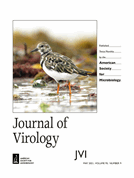Abstract Changes of mRNA 3’UTRs by alternative polyadenylation (APA) have been associated to numerous pathologies, but the mechanisms and consequences often remain enigmatic. By combining transcriptomics, proteomics and recombinant viruses we show that all tested strains of IAV, including A/PR/8/34(H1N1) (PR8) and A/Cal/07/2009 (H1N1) (Cal09), cause APA. We mapped the effect to the highly conserved… Continue reading mRNA 3’UTR lengthening by alternative polyadenylation attenuates inflammatory responses and correlates with virulence of Influenza A virus
Tag: Influenza
TWiV 1034: Clinical update with Dr. Daniel Griffin
In his weekly clinical update, Dr. Griffin discusses the immunogenicity, safety, and preliminary efficacy evaluation of OVX836, a nucleoprotein-based universal influenza A vaccine candidate, association between nose picking and SARS-CoV-2 incidence, a cohort study in hospital health care workers; effect of COVID-19 vaccination and booster on maternal-fetal outcomes, dynamics of inflammatory responses after SARS-CoV-2 infection… Continue reading TWiV 1034: Clinical update with Dr. Daniel Griffin
Loss of CD4+ T cell-intrinsic arginase 1 accelerates Th1 response kinetics and reduces lung pathology during influenza infection
West et al. demonstrate that CD4+ T cell-intrinsic arginase 1 paces the transition of Th1 cells from their induction to their contraction program via balancing glutamine vs. arginine usage. They further show that Th1 cells lacking arginase 1 retain full pathogen clearance capacity but cause less Th1-associated tissue pathology.
Comparison of genome replication fidelity between SARS-CoV-2 and influenza A virus in cell culture
Abstract Since the emergence of COVID-19, several SARS-CoV-2 (severe acute respiratory syndrome coronavirus 2) variants have emerged and spread widely. These variants are produced through replication errors of the viral genome by viral RNA-dependent RNA polymerase (RdRp). Seasonal epidemics of influenza are also known to occur because of new variants of influenza A virus (IAV),… Continue reading Comparison of genome replication fidelity between SARS-CoV-2 and influenza A virus in cell culture
A universal influenza vaccine – how does it work?
The study aims to investigate the safety, immunogenicity, and potential efficacy of OVX836 at different doses . Vaccine demonstrated an observed protection level of 84%, which was further corroborated by a pooled analysis . The findings are particularly encouraging, as they approach the target efficacy for a universal influenza vaccine (>75%)
TWiV 1033: Freediving with nanobodies and interferon
TWiV notes the passing of Harald zur Hausen, dengue breaking records in the Americas, inhibition of SARS-CoV-2 infection and inflammation by modulation of type I IFN, and an armed nanobody that protects mice against influenza A and B disease. Hosts: Vincent Racaniello, Kathy Spindler, and Angela Mingarelli Click arrow to playDownload TWiV 1033 (76 MB .mp3,… Continue reading TWiV 1033: Freediving with nanobodies and interferon
Influenza shows no seasonality in tropics, posing challenges for health care
In temperate climates, like North America and Europe, flu season starts in the fall, peaks in winter and ends in spring . Public health officials have generally assumed that influenza is also seasonal in tropical climates . But new research has found little evidence of a repeatable pattern in influenza cases in Vietnam .
The M2 proteins of bat influenza A viruses reveal atypical features compared to conventional M2 proteins
Co-evolution of immunity and seasonal influenza viruses
Abstract Seasonal influenza viruses cause recurring global epidemics by continually evolving to escape host immunity. The viral constraints and host immune responses that limit and drive the evolution of these viruses are increasingly well understood. However, it remains unclear how most of these advances improve the capacity to reduce the impact of seasonal influenza viruses… Continue reading Co-evolution of immunity and seasonal influenza viruses
Detection of human adenoviruses in influenza-negative patients with respiratory tract infections in Nanning, China
HAdV is associated with various clinical manifestations, including hepatitis,gastroenteritis, meningitis, cystitis, conjunctivitis, upper and lower respiratory tract infections, and myocarditis etc. [14,15,<a data-track="click" data-track-action="reference anchor" data-track-label="link" data-test="citation-ref" title="Chhabra P, Payne DC, Szilagyi PG et al. Etiology of viral gastroenteritis in children 16,17,18,19,20]. Moreover, HAdV infection spreads easily, is highly contagious in some cases, can cause… Continue reading Detection of human adenoviruses in influenza-negative patients with respiratory tract infections in Nanning, China


